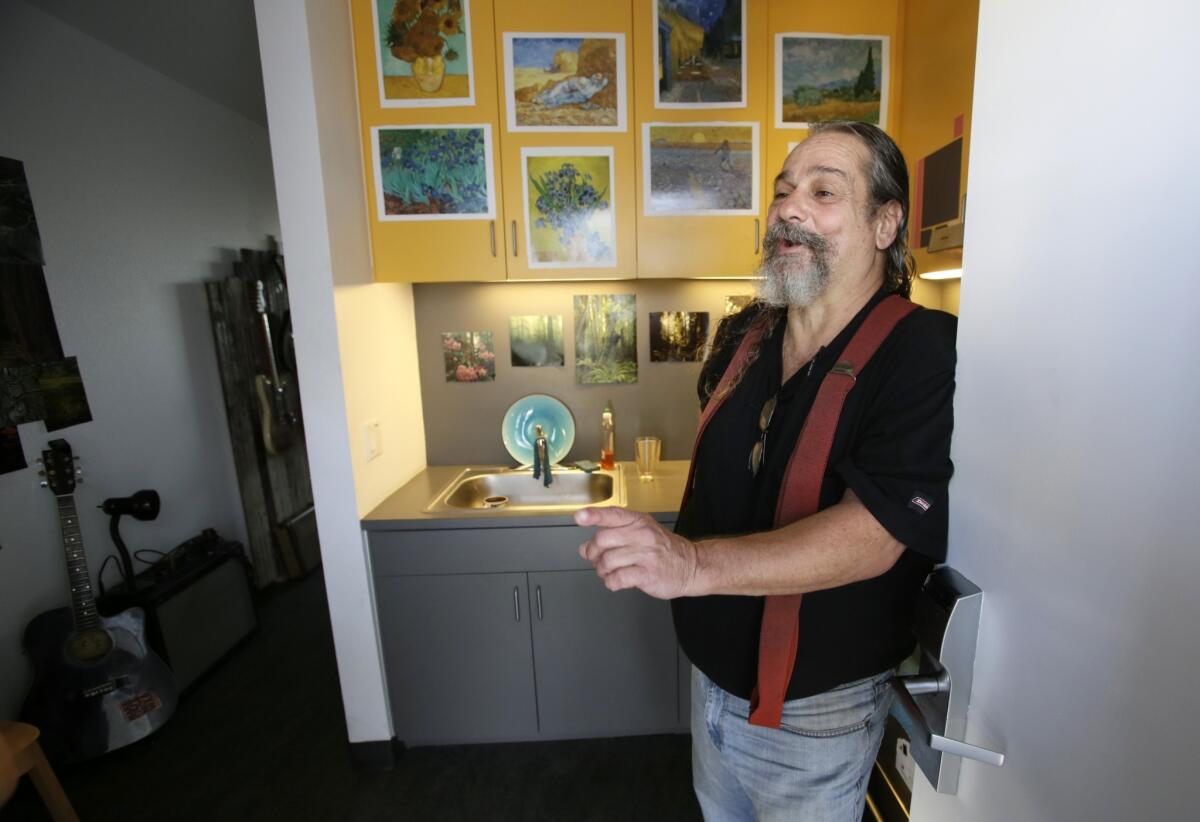Homes for L.A.’s homeless are finally coming online. Now we just need 10,000 more

- Share via
Finally, we see something concrete — literally — rising up from Proposition HHH, the bond measure that Los Angeles city voters approved to provide $1.2 billion to help build 10,000 units of housing mainly for chronically homeless people and for those with very low incomes. More than three years after the measure passed in November 2016, the first HHH housing development in the city — at 88th and Vermont — is now open.
That’s the long-awaited, overdue good news that city and county leaders celebrated last week. But even that needs to be viewed in depressing perspective: The project contains only 46 supportive units for chronically homeless people and 14 for very low-income residents. There are about 36,000 homeless people in the city of Los Angeles, more than one-quarter of whom are chronically homeless.
Even though we understand that permanent supportive housing for chronically homeless people takes time to finance, approve and build, the pace has been frustratingly slow. Meanwhile the pace at which people in Los Angeles city are becoming homeless is anything but slow; the number of homeless people rose 16% last year.
Mayor Eric Garcetti said last week that the speed at which HHH projects are opening will dramatically increase this year and over the next couple of years. There are 20 housing developments under construction now, and by the end of 2020 some 900 units will have become available. Overall, more than 7,400 units are in some phase of development or construction. Another 1,000 are expected to be built with HHH funds that were specifically set aside for innovative projects.
It will be very good news if thousands of homeless people get keys to permanent homes in the next couple of years. But as Garcetti acknowledged last week, even if permanent supportive housing is built for 10,000 homeless and poor people over the next several years with HHH funds, it won’t be enough to meet the needs of the homeless population here.
Of course, not all of the 36,000 homeless people in the city of Los Angeles are “chronically homeless,” meaning so disabled by mental illness, substance addiction or physical ailments that they need HHH-financed housing units with wraparound supportive services. Many just need a rent subsidy. Others need housing but without intensive support services. But even if only about 10,000 of those in the city are chronically homeless, as the last homeless count found, the HHH-funded units won’t be quite sufficient.
Meanwhile, the last thing L.A. needs is to lose housing. But that’s exactly what has happened over the last three years as the city lost almost 1,000 “board and care” beds.
Those are state-licensed facilities, usually run out of small apartment buildings or single-family homes. They can’t rival new supportive housing developments for amenities, but they serve as the last safety net for mostly low-income mentally ill adults and seniors who, without them, risk falling into homelessness. Garcetti, county officials, and the Los Angeles Homeless Services Authority have all urged California Gov. Gavin Newsom to set aside hundreds of millions of dollars to better subsidize board-and-care homes that struggle to stay in business with the paltry amount of state funding they currently get.
Last week, the governor set up the California Access to Housing and Services Fund in the state Department of Social Services that could be used, among other things, for board-and-care facilities. Additionally, he asked in his proposed state budget for $750 million to be directed to that fund.
That’s a good move. The Legislature should commit to it as soon as possible so the governor’s office can get moving. Philanthropic groups and nonprofits can put money into the fund as well.
The city and the state should be as committed to maintaining housing for vulnerable populations as they are to helping build it.
More to Read
A cure for the common opinion
Get thought-provoking perspectives with our weekly newsletter.
You may occasionally receive promotional content from the Los Angeles Times.









